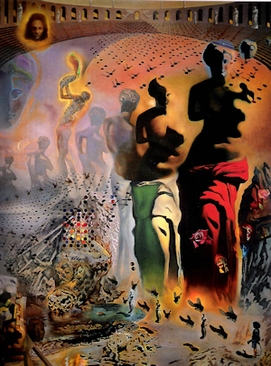The Hallucinogenic Toreador
The Hallucinogenic Toreador is a painting by the Spanish surrealist artist Salvador Dalí. Created between 1968 and 1970, this work is a prime example of Dalí's unique ability to blend reality with the fantastical, often incorporating multiple images and optical illusions within a single canvas.
Description[edit | edit source]
The painting measures 157 cm by 118 cm and is housed in the Dalí Theatre and Museum in Figueres, Catalonia, Spain. The central figure of the painting is a toreador, whose face is cleverly hidden within a series of abstract shapes and forms. The toreador's face is constructed from the elements of the Venus de Milo, a classical Greek statue, which appears multiple times throughout the painting.
Themes and Symbolism[edit | edit source]
Dalí's work often explores themes of dreams, subconscious, and psychoanalysis, heavily influenced by the theories of Sigmund Freud. In The Hallucinogenic Toreador, Dalí uses the image of the toreador to delve into themes of death, eroticism, and the Spanish Civil War. The painting also features numerous flies, which are a recurring motif in Dalí's work, symbolizing decay and the passage of time.
Optical Illusions[edit | edit source]
One of the most striking features of The Hallucinogenic Toreador is its use of optical illusions. The toreador's face is not immediately apparent; it emerges from the interplay of shadows and shapes, requiring the viewer to engage deeply with the painting. This technique is known as double imagery, a hallmark of Dalí's style.
Historical Context[edit | edit source]
The painting was created during a period of intense personal and artistic exploration for Dalí. The late 1960s and early 1970s were marked by a renewed interest in science and mathematics, which influenced many of his works from this period. Dalí was also deeply affected by the political turmoil in Spain, which is reflected in the somber and introspective tone of the painting.
Legacy[edit | edit source]
The Hallucinogenic Toreador is considered one of Dalí's masterpieces and continues to be a subject of extensive analysis and interpretation. It remains a popular attraction at the Dalí Theatre and Museum, drawing visitors from around the world who are eager to experience its complex and layered imagery.
See Also[edit | edit source]
References[edit | edit source]
External Links[edit | edit source]
Search WikiMD
Ad.Tired of being Overweight? Try W8MD's physician weight loss program.
Semaglutide (Ozempic / Wegovy and Tirzepatide (Mounjaro / Zepbound) available.
Advertise on WikiMD
|
WikiMD's Wellness Encyclopedia |
| Let Food Be Thy Medicine Medicine Thy Food - Hippocrates |
Translate this page: - East Asian
中文,
日本,
한국어,
South Asian
हिन्दी,
தமிழ்,
తెలుగు,
Urdu,
ಕನ್ನಡ,
Southeast Asian
Indonesian,
Vietnamese,
Thai,
မြန်မာဘာသာ,
বাংলা
European
español,
Deutsch,
français,
Greek,
português do Brasil,
polski,
română,
русский,
Nederlands,
norsk,
svenska,
suomi,
Italian
Middle Eastern & African
عربى,
Turkish,
Persian,
Hebrew,
Afrikaans,
isiZulu,
Kiswahili,
Other
Bulgarian,
Hungarian,
Czech,
Swedish,
മലയാളം,
मराठी,
ਪੰਜਾਬੀ,
ગુજરાતી,
Portuguese,
Ukrainian
Medical Disclaimer: WikiMD is not a substitute for professional medical advice. The information on WikiMD is provided as an information resource only, may be incorrect, outdated or misleading, and is not to be used or relied on for any diagnostic or treatment purposes. Please consult your health care provider before making any healthcare decisions or for guidance about a specific medical condition. WikiMD expressly disclaims responsibility, and shall have no liability, for any damages, loss, injury, or liability whatsoever suffered as a result of your reliance on the information contained in this site. By visiting this site you agree to the foregoing terms and conditions, which may from time to time be changed or supplemented by WikiMD. If you do not agree to the foregoing terms and conditions, you should not enter or use this site. See full disclaimer.
Credits:Most images are courtesy of Wikimedia commons, and templates Wikipedia, licensed under CC BY SA or similar.
Contributors: Prab R. Tumpati, MD

